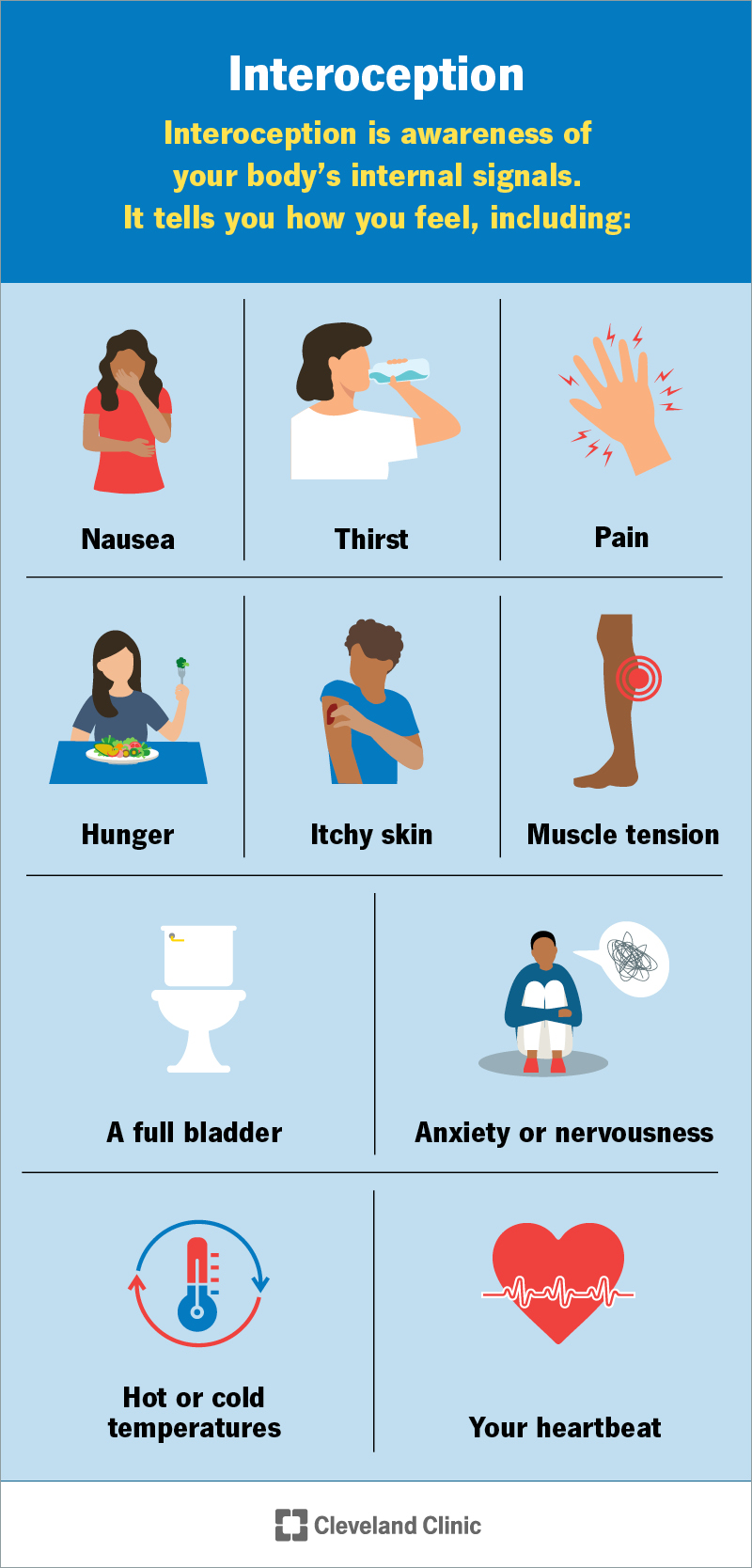Interoception is the understanding of your body’s internal senses. You can feel that you’re hungry, that your heart is beating or that you need to pee. It’s a learned skill that you develop as you grow. Certain conditions may make it more difficult for you to feel internal senses than others. Mindfulness exercises and therapy may help.
Advertisement
Cleveland Clinic is a non-profit academic medical center. Advertising on our site helps support our mission. We do not endorse non-Cleveland Clinic products or services. Policy

Interoception is awareness of your body’s internal senses or signals. It identifies how you feel.
Advertisement
Cleveland Clinic is a non-profit academic medical center. Advertising on our site helps support our mission. We do not endorse non-Cleveland Clinic products or services. Policy
You can consciously or unconsciously respond to these signals. For example, if your stomach rumbles, you know you’re hungry. You can go have a snack. Once you’ve satisfied your hunger, you’ve reached a state of balance — your body stops sending you hunger signals. This is called homeostasis.
As you grow and develop, you learn more about what important interoception skills are necessary, like feeling the need to pee or poop and knowing when to use the toilet.
It can also have a significant impact on your behavior and emotions. For example, if you’re in a dark room and your heart is beating fast, you might feel scared. By identifying how you feel, interoception helps you make a decision. In this example, you can decide to turn on a light.
Interoception may be more difficult for some to recognize and interpret than others. There are ways you can practice and improve your interoception skills. A healthcare provider may help you with this.
Examples of interoception include the following feelings:
There are three steps to the interoception process:
Advertisement
Your understanding of the sensation may be:
Certain mental health conditions like anxiety disorders may make you perceive benign sensations as threatening ones. This could potentially cause you to have more symptoms and stress. The opposite is true for depression, which may make it difficult for you to clearly identify a threatening sensation, like pain from an injury.
There are two types of interoception. They describe your ability to detect internal signals
You may be highly in tune with these signals, while others may not notice them. It varies significantly from person to person.
A healthcare provider might use different techniques to measure interoception functionality, like having you:
Your body tries to communicate these signals through signs and symptoms. Common signs of interoception include:
Common symptoms of interoception may include:
You might notice your interoception skills may not be working as well as expected if you experience any of the following common symptoms:
Many different conditions can affect how well interoception works. In some cases, interoception skills may not be fully developed.
The following conditions may affect how well you’re able to process interoception:
“Neurodivergence” is a term to describe brain functionality that differs from the norm. Interoception, or your ability to detect your body’s internal signals, may be heightened or not working as expected with neurodivergence.
Advertisement
Two examples of neurodivergent conditions that can affect your interoception include:
You can improve your interoception skills by:
A mental health professional or healthcare provider will discuss different ways you can meet your goals. These vary from person to person and may be unique to your situation. For example, electrical stimulation (like vagus nerve stimulation) may target areas of your brain to make communication between your body and brain easier.
You probably weren’t thinking about the feeling of your heart beating until now. Or maybe you’re thinking about what you’ll be eating for dinner and you feel your stomach growling. These are examples of interoception at work. Many conditions can interfere with how well you can use your interoception skills. If you’re looking to improve those skills, a healthcare provider can help. Have patience with yourself as you learn new techniques. This learned skill takes time to develop and doesn’t come naturally to everyone.
Advertisement
Advertisement
Your mental well-being is just as important as your physical well-being. Cleveland Clinic’s mental health experts can help you live life to the fullest.

Last reviewed on 02/19/2025.
Learn more about the Health Library and our editorial process.